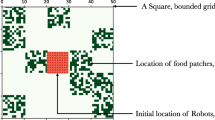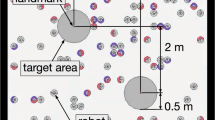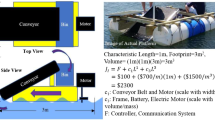Abstract
Renewable resources like fish stock or forests should be exploited at a rate that supports regeneration and sustainability—a complex problem that requires adaptive approaches to maintain a sufficiently high exploitation while avoiding depletion. In the presence of oblivious agents that cannot keep track of all available resources—a frequent condition in swarm robotics—ensuring that the exploitation effort is correctly balanced is particularly challenging. Additionally, the possibility to exploit resources by multiple robots opens the way to focusing the effort either on a single or on multiple resources in parallel. This means that the swarm needs to collectively decide whether to remain cohesive or split among multiple resources, as a function of the ability of the available resources to replenish after exploitation. In this paper, we propose a decentralised strategy for a swarm of robots that adapts to the available resources and balances the effort among them, hence allowing to maximise the exploitation rate while avoiding to completely deplete the resources. A detailed analysis of the strategy parameters provides insights into the working principles and expected performance of the robot swarm.







Similar content being viewed by others
References
Bailis, P., Nagpal, R., & Werfel, J. (2010) Positional communication and private information in honeybee foraging models. In Swarm intelligence (pp. 263–274). Berlin: Springer.
Bartumeus, F., da Luz, M. G. E., Viswanathan, G. M., & Catalan, J. (2005). Animal search strategies: A quantitative random-walk analysis. Ecology, 86(11), 3078–3087.
Bonabeau, E., Theraulaz, G., & Deneubourg, J.-L. (1996). Quantitative study of the fixed threshold model for the regulation of division of labour in insect societies. Proceedings of the Royal Society of London Series B: Biological Sciences, 263(1376), 1565–1569.
Bonani, M., Longchamp, V., Magnenat, S., Rétornaz, P., Burnier, D., Roulet, G., Vaussard, F., Bleuler, H., & Mondada, F. (2010) The marXbot, a miniature mobile robot opening new perspectives for the collective-robotic research. In Proceedings of the 2010 IEEE/RSJ international conference on intelligent robots and systems (IROS) (pp. 4187–4193). IEEE Press.
Borenstein, J., & Koren, Y. (1989). Real-time obstacle avoidance for fast mobile robots. IEEE Transactions on Systems, Man, and Cybernetics, 19(5), 1179–1187.
Castello, E., Yamamoto, T., Libera, F. D., Liu, W., Winfield, A. F. T., Nakamura, Y., et al. (2015). Adaptive foraging for simulated and real robotic swarms: The dynamical response threshold approach. Swarm Intelligence, 10(1), 1–31.
Cheein, F. A. A., & Carelli, R. (2013). Agricultural robotics: Unmanned robotic service units in agricultural tasks. IEEE Industrial Electronics Magazine, 7(3), 48–58.
Dimidov, C., Oriolo, G., & Trianni, V. (2016) Random walks in swarm robotics: An experiment with kilobots. In M. Dorigo, M. Birattari, X. Li, M. López-Ibáñez, K. Ohkura, C. Pinciroli, & T. Stützle (Eds.), Proceedings of the 10th international conference on swarm intelligence (ANTS 2016), volume 9882 of LNCS (pp. 185–196). New York: Springer.
Dorigo, M., Floreano, D., Gambardella, L., Mondada, F., Nolfi, S., Baaboura, T., et al. (2013). Swarmanoid: A novel concept for the study of heterogeneous robotic swarms. IEEE Robotics & Automation Magazine, 20(4), 60–71.
Dornhaus, A., Klügl, F., Oechslein, C., Puppe, F., & Chittka, L. (2006). Benefits of recruitment in honey bees: Effects of ecology and colony size in an individual-based model. Behavioral Ecology, 17(3), 336–344.
Ducatelle, F., Di Caro, G. A., Forster, A., Bonani, M., Dorigo, M., Magnenat, S., et al. (2014). Cooperative navigation in robotic swarms. Swarm Intelligence, 8(1), 1–33.
Granovskiy, B., Latty, T., Duncan, M., Sumpter, D. J. T., & Beekman, M. (2012). How dancing honey bees keep track of changes: The role of inspector bees. Behavioral Ecology, 23(3), 588–596.
Gutiérrez, A., Campo, A., Monasterio-Huelin, F., Magdalena, L., & Dorigo, M. (2010). Collective decision-making based on social odometry. Neural Computing & Applications, 19(6), 807–823.
Hecker, J. P., & Moses, M. E. (2015). Beyond pheromones: Evolving error-tolerant, flexible, and scalable ant-inspired robot swarms. Swarm Intelligence, 9(1), 1–28.
Holme, P., & Saramäki, J. (2012). Temporal networks. Physics Reports, 519(3), 97–125.
Hui, C. (2006). Carrying capacity, population equilibrium, and environment’s maximal load. Ecological Modelling, 192(1–2), 317–320.
Krieger, M. J. B., Billeter, J.-B., & Keller, L. (2000). Ant-like task allocation and recruitment in cooperative robots. Nature, 406(6799), 992–995.
Labella, T. H., Dorigo, M., & Deneubourg, J.-L. (2006). Division of labor in a group of robots inspired by ants’ foraging behavior. ACM Transactions on Autonomous Adaptive Systems, 1(1), 4–25.
Liemhetcharat, S., Yan, R., & Tee, K. P. (2015). Continuous foraging and information gathering in a multi-agent team. In Proceedings of the 2015 international conference on autonomous agents and multiagent systems (AAMAS) (pp. 1325–1333). Richland, SC: International Foundation for Autonomous Agents and Multiagent Systems.
Liu, W., & Winfield, A. F. T. (2010). Modeling and optimization of adaptive foraging in swarm robotic systems. The International Journal of Robotics Research, 29(14), 1743–1760.
Liu, W., Winfield, A. F. T., Sa, J., Chen, J., & Dou, L. (2007). Towards energy optimization: Emergent task allocation in a swarm of foraging robots. Adaptive Behavior, 15(3), 289–305.
Loreto, V., Baronchelli, A., Mukherjee, A., Puglisi, A., & Tria, F. (2011). Statistical physics of language dynamics. Journal of Statistical Mechanics: Theory and Experiment, 2011(04), P04006.
Miletitch, R., Trianni, V., Campo, A., & Dorigo, M. (2013) Information aggregation mechanisms in social odometry. In Proceedings of the 20th European conference on artificial life (ECAL 2013) (pp. 102–109). Cambridge, MA: MIT Press.
Moretti, P., Baronchelli, A., Starnini, M., & Pastor-Satorras, R. (2013). Generalized voter-like models on heterogeneous networks. In A. Mukherjee, M. Choudhury, F. Peruani, N. Ganguly, & B. Mitra (Eds.), Dynamics on and of complex networks, volume 2: Applications to time-varying dynamical systems (pp. 285–300). New York: Springer.
Murphy, R. R., Tadokoro, S., Nardi, D., Jacoff, A., Fiorini, P., Choset, H., & Erkmen, A. M. (2008). Search and rescue robotics. In Springer handbook of robotics (pp. 1151–1173). Springer.
Pais, D., Hogan, P. M., Schlegel, T., Franks, N. R., Leonard, N. E., & Marshall, J. A. R. (2013). A mechanism for value-sensitive decision-making. PLoS ONE, 8(9), e73216.
Perna, A., & Latty, T. (2014). Animal transportation networks. Journal of The Royal Society Interface, 11(100), 20140334–20140334.
Pinciroli, C., Trianni, V., O’Grady, R., Pini, G., Brutschy, A., Brambilla, M., et al. (2012). ARGoS: A modular, parallel, multi-engine simulator for multi-robot systems. Swarm Intelligence, 6(4), 271–295.
Pitonakova, L., Crowder, R., & Bullock, S. (2016). Information flow principles for plasticity in foraging robot swarms. Swarm Intelligence, 10(1), 33–63.
Reina, A., Marshall, J. A. R., Trianni, V., & Bose, T. (2017). Model of the best-of-n nest-site selection process in honeybees. Physical Review E, 95(5), 052411–15.
Reina, A., Miletitch, R., Dorigo, M., & Trianni, V. (2015a). A quantitative micro-macro link for collective decisions: the shortest path discovery/selection example. Swarm Intelligence, 9(2–3), 75–102.
Reina, A., Valentini, G., Fernández-Oto, C., Dorigo, M., & Trianni, V. (2015b). A design pattern for decentralised decision making. PLoS ONE, 10(10), e0140950–18.
Roberts, J., Stirling, T. S., Zufferey, J.-C., & Floreano, D. (2009) 2.5D infrared range and bearing system for collective robotics. In Proceedings of the 2009 IEEE/RSJ international conference on intelligent robots and systems (IROS) (pp. 3659–3664). IEEE Press.
Saleh, N., & Chittka, L. (2006). Traplining in bumblebees (Bombus impatiens): A foraging strategy’s ontogeny and the importance of spatial reference memory in short-range foraging. Oecologia, 151(4), 719–730.
Schroeder, A., Ramakrishnan, S., Kumar, M., & Trease, B. (2017). Efficient spatial coverage by a robot swarm based on an ant foraging model and the lévy distribution. Swarm Intelligence, 11(1), 39–69.
Seeley, T. D., Visscher, P. K., Schlegel, T., Hogan, P. M., Franks, N. R., & Marshall, J. A. R. (2012). Stop signals provide cross inhibition in collective decision-making by Honeybee swarms. Science, 335(6064), 108–111.
Simpson, S. J., Sibly, R. M., Lee, K. P., Behmer, S. T., & Raubenheimer, D. (2004). Optimal foraging when regulating intake of multiple nutrients. Animal Behaviour, 68(6), 1299–1311.
Song, Z., & Vaughan, R. T. (2013) Sustainable robot foraging: Adaptive fine-grained multi-robot task allocation for maximum sustainable yield of biological resources. In Proceedings of the 2013 IEEE/RSJ international conference on intelligent robots and systems (IROS) (pp. 3309–3316). IEEE Press.
Spranger, M. (2013). Evolving grounded spatial language strategies. Künstliche Intelligenz, 27(2), 97–106.
Steels, L., & Belpaeme, T. (2005). Coordinating perceptually grounded categories through language: A case study for colour. The Behavioral and brain sciences, 28(04), 1–61.
Trianni, V., & Campo, A. (2015). Fundamental collective behaviors in swarm robotics. In J. Kacprzyk & W. Pedrycz (Eds.), Springer handbook of computational intelligence (pp. 1377–1394). Berlin: Springer.
Trianni, V., & Dorigo, M. (2005). Emergent collective decisions in a swarm of robots. In Proceedings of the 2005 IEEE swarm intelligence symposium (SIS 2005) (pp. 241–248).
Valentini, G., Ferrante, E., & Dorigo, M. (2017). The best-of-n problem in robot swarms: Formalization, state of the art, and novel perspectives. Frontiers in Robotics and AI, 4, 1–43.
Winfield, A. F. (2009). Foraging robots. In Encyclopedia of complexity and systems science (pp. 3682–3700). New York: Springer.
Yoshida, K. (2009). Achievements in space robotics. IEEE Robotics & Automation Magazine, 16(4), 20–28.
Acknowledgements
Vito Trianni acknowledges the support by the European Commission FP7 Programme People: Marie-Curie Actions through the project “DICE, Distributed Cognition Engineering” (Grant Agreement Number 631297). Marco Dorigo acknowledges the support from the Belgian F.R.S.-FNRS, of which he is a Research Director.
Author information
Authors and Affiliations
Corresponding author
Additional information
Guest editor: Roderich Groß.
Electronic supplementary material
Below is the link to the electronic supplementary material.
Rights and permissions
About this article
Cite this article
Miletitch, R., Dorigo, M. & Trianni, V. Balancing exploitation of renewable resources by a robot swarm. Swarm Intell 12, 307–326 (2018). https://doi.org/10.1007/s11721-018-0159-8
Received:
Accepted:
Published:
Issue Date:
DOI: https://doi.org/10.1007/s11721-018-0159-8




